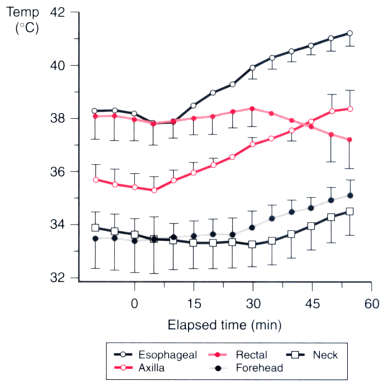Figure 40-25
Axillary and esophageal temperatures correlated well
during acute malignant hyperthermia in swine, but forehead and neck skin temperatures
did not. Rectal temperature also failed to promptly identify the onset of malignant
hyperthermia. Elapsed time zero indicates an end-tidal PCO2
of 70 mm Hg. These data indicate that forehead and neck skin surface temperatures
will not adequately confirm other clinical signs of malignant hyperthermia. Valid
core temperature monitoring sites include the distal part of the esophagus, pulmonary
artery, nasopharynx, and tympanic membrane. Except during cardio-pulmonary bypass,
body temperature can also be measured in the mouth, axilla, and bladder. Data are
presented as means ± SD. (Redrawn with modification from laizzo PA,
Zink RS, Kehler CH, et al: Skin and central temperature during malignant hyperthermia
in swine [abstract]. Anesthesiology 77:A569, 1992.)

